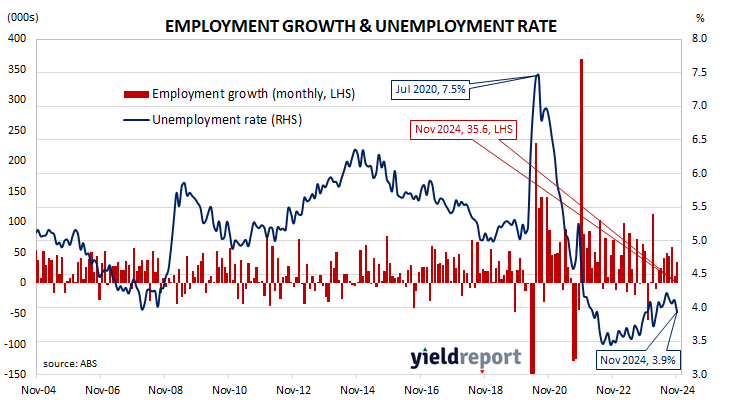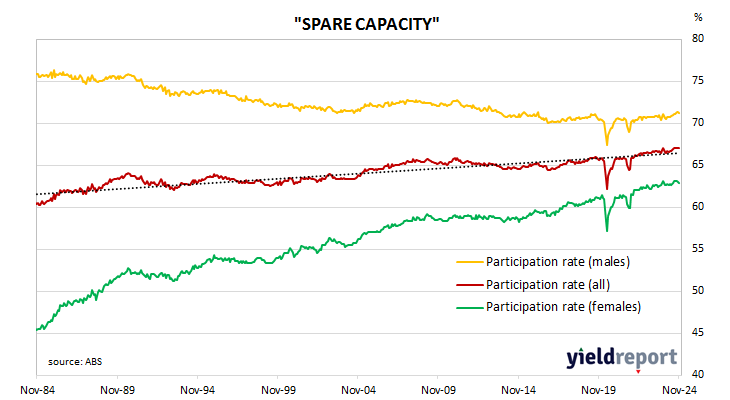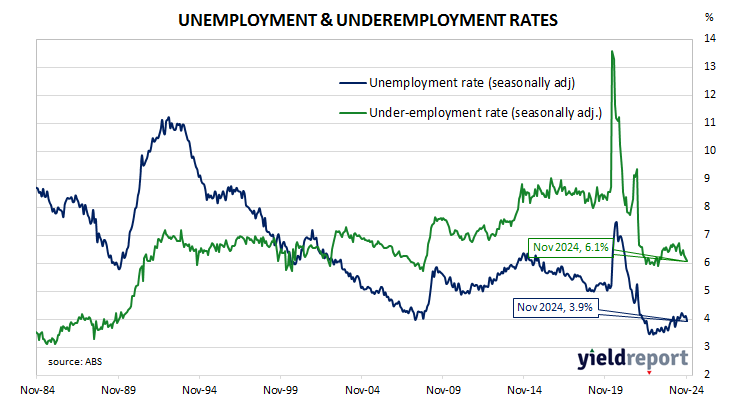Summary: Employment up 35,600 in November, greater than expected; Westpac: delivers some notable surprises; ACGB yields rise; rate-cut expectations soften; ANZ: offsets recent GDP data somewhat; Westpac: risk of an unwind in December; participation rate declines to 67.0%; jobless rate falls to 3.9%; fewer part-time jobs, more full-time jobs; aggregate work hours unchanged; underemployment rate falls to 6.1%.
Australia’s period of falling unemployment came to an end in early 2019 when the jobless rate hit a low of 4.9%. It then averaged around 5.2% through to March 2020, bouncing around in a range from 5.1% to 5.3%. Leading indicators such as ANZ-Indeed’s Job Ads survey and NAB’s capacity utilisation estimate suggested the unemployment rate would rise in the June 2020 quarter and it did so, sharply. The jobless rate peaked in July 2020 but fell below 7% a month later and then trended lower through 2021 and 2022.
The latest Labour force figures have now been released and they indicate the number of people employed in Australia according to ABS definitions increased by 35,600 in November. The result was greater than the 25,000 rise which had been generally expected as well as October’s downwardly-revised increase of 12,200.
“The November Labour Force Survey delivered some notable surprises, which on face value could be seen as indicative of a retightening in conditions,” said Westpac economist Ryan Wells. “However, we caution that these results rely on some curious developments around labour supply and gross flows within the labour market.”
Commonwealth Government bond yields rose noticeably on the day. By the close of business, the 3-year ACGB yield had jumped 11bps to 3.84%, the 10-year had gained 8bps to 4.28% while the 20-year yield finished 9bps higher at 4.63%.
Expectations regarding rate cuts in the next twelve months softened, although a February cut is still currently viewed as a solid chance. Cash futures contracts implied an average of 4.285% in February, 4.025% in May and 3.74% in August. November contracts implied 3.605%, 73bps less than the current cash rate.
“Softer economic data from the recent national accounts release raised the risk of a February cut but this labour market result offsets that risk somewhat,” said ANZ economist Adelaide Timbrell.
“We saw something similar in late 2023 that proved to be a ‘head fake’, with shifting seasonality also presenting as an issue,” Westpac’s Wells noted. “There is a risk of an unwind in December, emphasising the need to contextualise these results within the multi-month trend.”
The participation rate slipped from October’s revised series-high of 67.1% to 67.0% as the total available workforce increased by 8,600 to 15.131 million. The number of unemployed persons decreased by 27,000 to 595,300 and the unemployment rate declined from 4.1% to 3.9%.
The aggregate number of hours worked across the economy remained unchanged after rounding even as 17,000 residents lost part-time positions and 52,600 residents gained full-time positions. On a 12-month basis and after revisions, aggregate hours worked increased by 2.1% as 106,400 more people held part-time positions and 226,100 more people held full-time positions than in November 2023.
More attention has been paid to the underemployment rate in recent years, which is the number of people in work but who wish to work more hours than they do currently. November’s underemployment rate declined from 6.2% to 6.1%, 0.2 percentage points above this cycle’s low.
The underutilisation rate, that is the sum of the underemployment rate and the unemployment rate, has a strong correlation with the annual growth rate of the ABS private sector wage index when advanced by two quarters. November’s underutilisation rate of 10.0% corresponds with an annual growth rate of about 4.2%.




